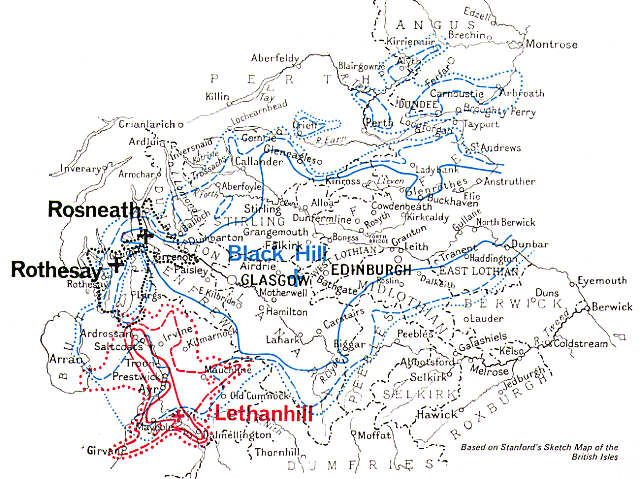 |
UK Broadcast Transmission |
|
|||||||||||
ITV 405 line VHF TV TRANSMITTERS
CENTRAL SCOTLAND
| BLACK HILL | Lethanhill | Rosneath | Rothesay | |
| Channel / Polarisation | 10V | 12 V | 13 V | 8 V |
| Max. Vision ERP | 475 kW | 3 kW | 0.1 kW | 1 kW |
| Site ASL | 903 ft | 1000 ft | 345 ft | 516 ft |
| Aerial ASL | 1853 ft | 1135 ft | 460 ft | 651 ft |
| Location (NGR) | NS 828647 | NS 438106 | NS 258812 | NS 125690 |

The authority's Black Hill station serves nearly 4 million people in the central lowlands of Scotland. The construction of the Black Hill station, on a site 900 ft above sea level and midway between Glasgow and Edinburgh, began in the late summer of 1956. The selection of the site was straightforward, but there was difficulty in obtaining the land. A study of the topography within the required service area of this station established the need for a 750 ft mast and it was evident that the best possible coverage could be obtained only by using a directional aerial system. It was important that, if possible, both Dundee in the north-east and the towns on the Ayrshire coast in the west should be included in the service area. Little benefit, however, would result from radiating high power in the hilly northwesterly or south-easterly directions. It thus appeared that an aerial having an elliptical power distribution pattern with its major axis aligned to the north-east and south-west would provide the best result. An international limitation on power in certain directions, however, made it necessary to compromise and to design an aerial whose radiation pattern can best be described as 'boot-shaped', the 'heel' (250 kW) directed towards the south-west and the 'sole' (475 kW) directed to the north-east. A power of about 150 kW was adequate for the northwest and south-east directions. A novel16-stack vertically-polarized directional aerial system was developed, possessing many useful features, which attempted to approximate to the optimum power-radiation pattern. The aerial was located centrally within the mast structure to radiate through the opening of the lattice steel formation of the mast, mainly to reduce the wind loading and icing on the exposed site. Unfortunately, complex anomalies in the behaviour of this aerial caused its performance to deviate from the prediction. The desired power in the various directions was not completely achieved, while the polarisation of radiation in the south-west sector in the direction of Ayr was predominantly horizontal instead of vertical. The result was a marginal shift in the potential service area of the station. These anomalies had to be accepted for the time being, and the station came into service on 31st August 1957. In 1959 it was decided to replace the 'inside the mast' aerial by one of more conventional form, with the radiators mounted outside the mast. In order to ensure continuity of service, it was also decided to erect the replacement aerial on a new 1,000 ft mast near the original mast. The difficult job of constructing the new mast close to the old began in August 1960. Together with the new aerial it was brought into use on 10th July 1961. The 750 ft mast was dismantled and has been used at the Selkirk station in the Borders. The performance of the new aerial at Black Hill is satisfactory and has resulted in an extension of the service area and in improvements to reception generally. Three new small relay stations were built by the Authority to bring a new or improved service to the areas of Rothesay, Rosneath, and Lethanhill in Central Ayrshire. In line with current practice, these stations were automatically controlled transposers with 'call-out' facilities in the case of breakdown. Rothesay came into service on 30/08/1968, Rosneath on 13/12/1968 and Lethanhill on 31/01/1969. |
|